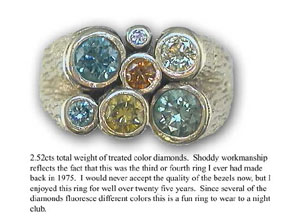This is my first posting to this site. It is amazing what I have learned from everyone''s various entries these past few months. GREAT SITE!!!
Question - is there a visual difference between a ''VG'' versus ''EX'' versus ''ID'' Polish and Symmetry ratings for a brilliant cut - approx .80cts?
I suspect the symmetry differences between the three ratings could be detectable with the unaided eye - but not sure.
I have narrowed my search to various center stones that primarily differ by these two characteristics (Polish , Sym).
Also - is there a significant visual (unaided eye) difference between a Flourescence rating of ''N'' versus ''F'' versus ''MB'' - given the ring is in everyday conditions of sunlight and typical indoor lighting?
Thanks to everyone for their candid comments and interest to provide useful info on this site.
Question - is there a visual difference between a ''VG'' versus ''EX'' versus ''ID'' Polish and Symmetry ratings for a brilliant cut - approx .80cts?
I suspect the symmetry differences between the three ratings could be detectable with the unaided eye - but not sure.
I have narrowed my search to various center stones that primarily differ by these two characteristics (Polish , Sym).
Also - is there a significant visual (unaided eye) difference between a Flourescence rating of ''N'' versus ''F'' versus ''MB'' - given the ring is in everyday conditions of sunlight and typical indoor lighting?
Thanks to everyone for their candid comments and interest to provide useful info on this site.






300x240.png)